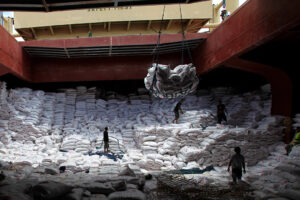
Rice EO signals greater PHL openness to trade — BCCP
By Chloe Mari A. Hufana
EXECUTIVE ORDER (EO) No. 62, which cut rice import tariffs to 15% from 35% signals that the Philippines is opening itself up to more trade, the British Chamber of Commerce of the Philippines (BCCP) said.
“When you reduce tariffs… that helps because your signal is that the Philippines is more and more open to trade and investment,” BCCP Executive Director and Trustee Christopher James Nelson told BusinessWorld by phone.
“There’s a lot of interest (from foreign investors) and clearly the signal that the President sent by reducing (rice tariffs) is very good,” he added.
Mr. Nelson added that EO 62 benefits the Philippines because cheaper overseas products will be available in Philippine markets, keeping prices lower.
American Chamber of Commerce of the Philippines, Inc. Agribusiness Chair Christopher A. Ilagan told BusinessWorld via Viber that the Philippines is an important partner for American agricultural business. It is the ninth-largest export market for US agricultural goods.
“EO 62 offers more predictability as it ensures a clear and transparent tariff regime over the next few years, unlike the previous practice of annually renewing the tariff rates, keeping on edge those who are reliant on these trade flows,” he added.
Mr. Ilagan added that improved predictability will keep prices and trade volumes steady instead of fluctuating, especially at the end of financial years.
“Better predictability and policy stability are basic characteristics foreign traders and investors rely on for longer-term commitments in the market,” he added.
Mr. Marcos last month issued EO 62 as an inflation-containment measure.
Rice inflation in June eased to 22.5% from 23% in May for a third straight month of declines.
The Philippine Statistics Authority last week said the price of a kilo of well-milled rice fell to P55.96 in June from P56.06 in May.
Regular-milled rice prices increased to P51.07 in June from P51.03 in May, and special rice prices rose to P64.56 in June from P64.41 in May.
“Tariff cuts will evidently lower the price of rice; the assumption is that the gain from the tariff reduction is fully passed on to the consumer. Another assumption is that market prices remain constant,” Action for Economic Reforms coordinator Filomeno S. Sta. Ana III told BusinessWorld in a Viber message.
“That said, we cannot simply rely on imports despite tariff cuts. The sustainable, longest-term solution is to increase our agricultural efficiency and farmers’ productivity,” he added.
Mr. Ilagan said that lower tariffs for commodities the Philippines is short on can help in managing affordability.
“EO 62 will help the majority of Filipinos in managing their food-related expenses while also supporting the food industry in general that is reliant on a number of imported ingredients to create value addition through food production and service,” Mr. Ilagan added.
On Thursday, farmer groups asked the Supreme Court for a temporary restraining order to block EO 62, saying they were not consulted on the tariff adjustments as required by law.
Mr. Ilagan said any tariffs that will be raised should still be reinvested in Filipino farmers.
“These funds can be used to support farmers affected by the increased competition from abroad, while also earmarking these revenues to invest in enhancing the competitiveness of the sector, especially those sub-sectors whose produce are heavily reliant on for our own food security, such as rice, corn, and meat products,” he said.
Finance Secretary Ralph G. Recto in June said the government will forego up to P22 billion in revenue due to the tariff cut. He described the move as “short-term,” citing the need not to be too reliant on imported rice.



